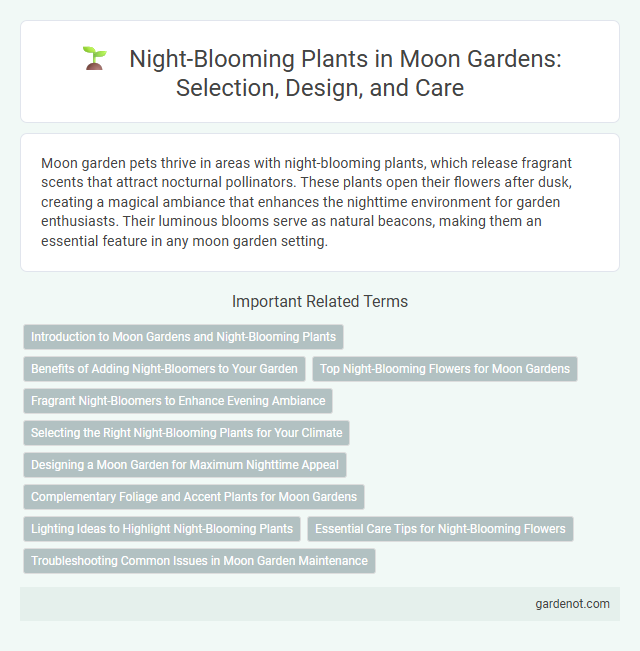Moon garden pets thrive in areas with night-blooming plants, which release fragrant scents that attract nocturnal pollinators. These plants open their flowers after dusk, creating a magical ambiance that enhances the nighttime environment for garden enthusiasts. Their luminous blooms serve as natural beacons, making them an essential feature in any moon garden setting.
Introduction to Moon Gardens and Night-Blooming Plants
Moon gardens showcase night-blooming plants such as moonflowers, evening primroses, and night-blooming jasmine, which release sweet fragrances and vibrant blossoms after sunset. These plants attract nocturnal pollinators like moths and bats, enhancing the garden's ecological balance. Incorporating moon gardens creates a serene nighttime landscape that highlights the beauty and mystery of flowers that thrive in moonlight.
Benefits of Adding Night-Bloomers to Your Garden
Night-blooming plants like moonflowers and night-blooming jasmine attract nocturnal pollinators such as moths and bats, enhancing biodiversity in your garden. These plants emit sweet fragrances and luminous blooms that create a serene, magical atmosphere ideal for evening relaxation. Incorporating night-bloomers extends the garden's visual interest and sensory appeal beyond daylight hours, maximizing space and plant diversity.
Top Night-Blooming Flowers for Moon Gardens
Top night-blooming flowers for moon gardens include the fragrant Night-Blooming Jasmine, whose creamy white blossoms release a sweet aroma after dusk, and the delicate Evening Primrose, known for its bright yellow petals that open at night. Moonflower vines add large, luminous blooms that attract nocturnal pollinators like moths, enhancing the garden's nighttime appeal. Other notable plants are Four O'Clocks, which offer vivid colors and captivating scents throughout the evening.
Fragrant Night-Bloomers to Enhance Evening Ambiance
Fragrant night-blooming plants such as evening primrose, night-blooming jasmine, and moonflower add enchanting scents that intensify the serene atmosphere of a moon garden. These blossoms release their aroma after dusk, attracting pollinators like moths while creating a peaceful sensory experience for nighttime visitors. Incorporating a mix of these fragrant night-bloomers enhances the garden's evening ambiance and supports local nocturnal wildlife.
Selecting the Right Night-Blooming Plants for Your Climate
Selecting the right night-blooming plants for your climate involves understanding temperature ranges, humidity levels, and soil conditions that support nocturnal flowering species such as Moonflowers, Evening Primroses, and Night Phlox. Hardy varieties like Angel's Trumpet thrive in warmer USDA zones 9-11, while plants like Nicotiana can tolerate cooler temps of zones 7-10. Matching these night-bloomers to your local environment ensures vibrant blooms and optimal growth in a moon garden setting.
Designing a Moon Garden for Maximum Nighttime Appeal
Selecting night-blooming plants like evening primrose, moonflower, and night-blooming jasmine ensures a vibrant moon garden with captivating fragrances and luminous petals under moonlight. Incorporate reflective surfaces such as white gravel or pale stone pathways to enhance moonlight visibility and amplify the garden's ethereal glow. Position plants strategically to create layered height and texture, maximizing visual interest and sensory appeal during nighttime.
Complementary Foliage and Accent Plants for Moon Gardens
Night-blooming plants in moon gardens thrive when paired with complementary foliage such as silver artemisia and dusty miller, whose pale, textured leaves reflect moonlight and enhance nighttime visibility. Accent plants like white-flowered angel's trumpet and fragrant night phlox provide contrasting shapes and subtle scents that create a multisensory garden experience after dark. Selecting a mix of these foliage and flowering plants maximizes the ethereal beauty and serene ambiance characteristic of an enchanting moon garden.
Lighting Ideas to Highlight Night-Blooming Plants
Incorporate soft LED uplighting to accentuate night-blooming plants like moonflowers and evening primroses, enhancing their delicate petals after dusk. Use solar-powered stake lights strategically placed to create subtle shadows that emphasize the plants' unique shapes and fragrances. Integrate string lights with warm tones nearby to provide ambient illumination without overpowering the natural allure of the blossoms.
Essential Care Tips for Night-Blooming Flowers
Night-blooming flowers such as the Moon Garden species thrive in well-drained soil with consistent moisture but avoid waterlogging to prevent root rot. These plants benefit from partial to full moonlight exposure, which enhances blooming and supports their nocturnal pollination. Regular pruning after blooming sessions promotes healthy growth and maximizes flower production during the night.
Troubleshooting Common Issues in Moon Garden Maintenance
Night-blooming plants in a moon garden often face challenges such as insufficient light, pests like aphids and caterpillars, and fungal diseases caused by poor air circulation. Regular inspection for signs of leaf discoloration, wilting, or unusual spots can help identify early problems. Implementing proper watering techniques, ensuring adequate spacing, and using natural pest control methods can effectively maintain the health and vibrancy of night-blooming species.
Night-blooming plant Infographic

 gardenot.com
gardenot.com